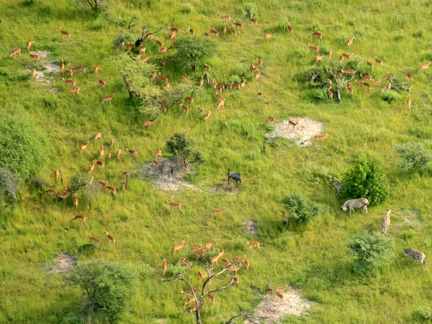Chief’s Island’s beautiful “Chloe”
The clouds were hanging low and closing, as EWB took to the sky once again to head into the Okavango Delta this weekend. Our task was to find a representative elephant herd on Chief’s Island located in the middle of the delta, in order to deploy a satellite collar on a female so that we may monitor her herd’s movements on and off the Island. There is plenty of water already in the delta, which made it difficult for me to get my bearings to know the areas we were flying over. However, as soon as we were over the island it was easy. Despite the rains bringing the vegetation to a thick green mass, new waters flooding the area, and yet considering having flown the entire island only a few months ago during our aerial survey (read about the survey: https://elephantswithoutborders.org/blog/?p=711) it was easily recognized by the masses of impala, numbers of zebra, giraffe and elephants. However, the one unfortunate characteristic is the amount of fallen trees.

Impala numbers are in the thousands on the Island. What impact does that have on the re-generation of trees?
As recent as 2002, the area was not known for huge numbers of elephants. Reports given by the lodge managers in the area, said that it would be difficult to find an elephant especially during the rainy season, back then. Of course, the waters in the delta are at an ever changing level, so there are times of the year that elephants and wildlife can move easily on to or off the island. But for some reason, they are staying longer and with every year the numbers of elephants visiting or residing on the island increase. Due to this population increase, there is growing concern over the recent habitat changes on the island as well, which are mainly attributed to these large elephant numbers and masses of impala.
What EWB aims to do with this study is eventually provide reliable information on the role of elephants on the vegetation in the region. We are trying to answer questions about how much of the structural and compositional change of the island’s tree community is attributed to elephants and how much may be attributed to other herbivores, like impala, and possibly fires and climate change. Along with that, we would like to address the question on how do elephants affect the density and diversity of other wildlife species. In combination with monitoring elephant herd movements and their duration on the island, assessing the wildlife populations and proposed vegetation studies, we will be able to provide the needed information critical for land-use planning and habitat protection. (to learn more about our monitoring programs, see http://www.elephantswithoutborders.org/tracking.php)

M. Chase, P. Perlstein & Mombo's camp Manager, Brendan discuss their plan to protect certain large trees
On this particular day, we had no trouble finding elephant herds and bulls. A female, one amongst a herd of appox. 25 elephants, was selected for the satellite collar to be deployed on. We couldn’t get an accurate count on her specific herd size, partly due to the thick shrubs, partly due to the numbers of other elephant herds around and partly due to the amount of young calves amongst the herds. The collaring exercise went quickly and smoothly. And as she stood up from her immobilization, we all took a gasp, admiring how truly magnificent, beautiful and healthy she looked. Her name is “Chloe”, donned by our generous donor, Jeff Neu, naming her in honor of his niece living in New York City, USA.
We would like to express our sincere gratitude to Mr. Jeff Neu for his keen interest in elephants and providing us with initial support to conduct this study, and our collaborative partners at Wilderness Wildlife Trust for securing this event. (read more about our collaboration on http://www.elephantswithoutborders.org/collaborations.php) We’d also like to thank the rhino monitoring team at Wilderness’s Mombo Camp for agreeing to help track Chloe, take notes and visual sightings of her while she is in their area. Thank you to the Department of Wildlife and National Parks for their continued endorsement and support of our conservation research endeavors.
To read more about Elephants Without Borders, see http://www.elephantswithoutborders.org/
If you would like to support our projects, please contact us at info@elephantswithoutborders.org or make a donation at http://www.elephantswithoutborders.org/donate.php We sincerely appreciate your support!
Tags: africa, botswana, Chief's Island, conservation, elephants, elephants without borders, Okavango delta, research, satellite








